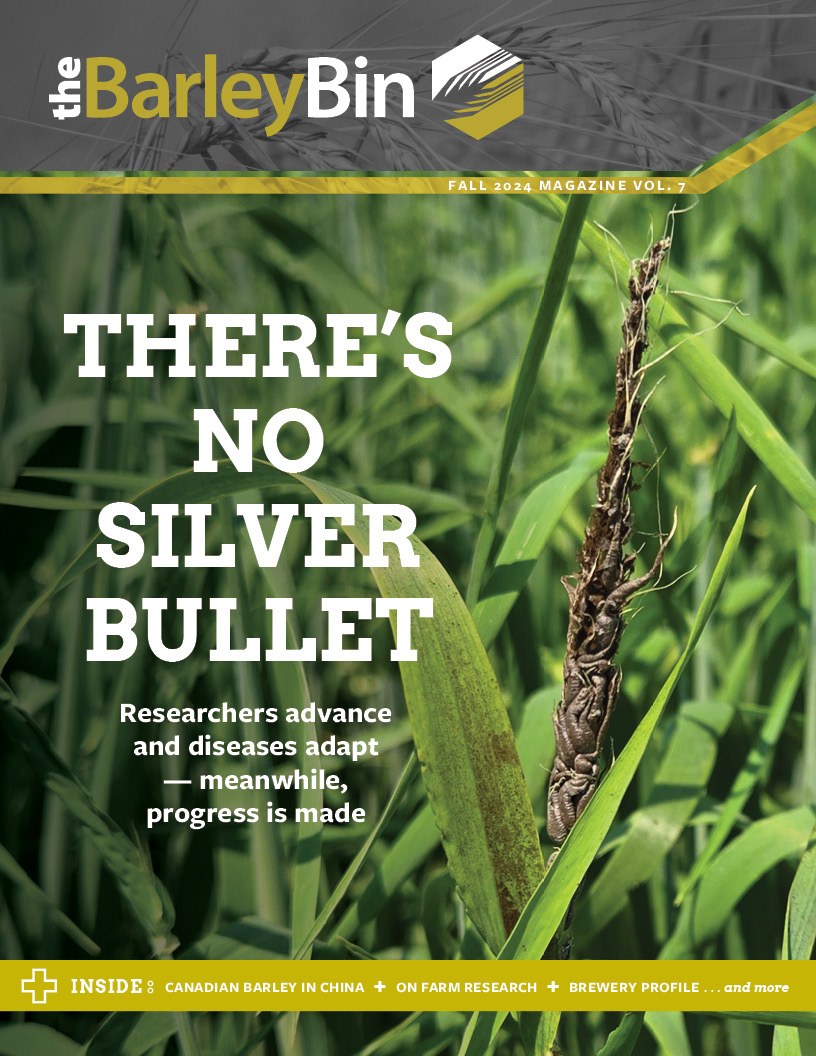Enhanced Agronomy Trials Reveal Best Barley Varieties and Input Strategies
By: Geoff Geddes, freelance writer
With new barley varieties like CDC Durango and AAC Prairie, SaskBarley’s Enhanced Agronomy Project is putting malt and feed options through their paces. From nitrogen rates to PGRs, researchers aim to uncover the best fit for farmers.
Durango versus Wrangler sounds like a battle of the jeans, as well it should. SaskBarley’s Enhanced Agronomy Project is all about finding the right fit for your farm. In collaboration with the East Central Research Foundation (ECRF) and Suncrest College, the current study is testing a pair of two row malt barley varieties – AAC Prairie and CDC Churchill – and two row feed varieties CDC Durango and AB Wrangler. All lines will experience standard versus enhanced rates of N (nitrogen), “PGR (plant growth regulator) versus no PGR” and “fungicide versus no fungicide”.
Part of the value from these trials stems from the thoroughness of researchers. For 2024-25, they are using both standard and enhanced rates of N fertility (soil (0-24”) + added N], which will vary among locations based on historic yield. The sites fall into three groupings, with yield potential obtained from data provided by the Saskatchewan Crop Insurance Corporation (SCIC).

Group 1 in Swift Current features low yield potential and 100 versus 125 lb N/ac. The mid-range Group 2 is situated in Indian Head and Scott, and offers 120 versus 150 lb N/ac. Finally, Group 3 in Yorkton and Melfort boasts high yield potential with 130 versus 162 lb N/ac.
All sites are being fertilized with P and K levels so as not to be limiting, even for the high N rate, and all will receive added N.
For those seeking the devilish details, the trials are applying the PGR Moddus at stem elongation, and the fungicide will be either Trivapro or Nexicor, applied at flag leaf.
“These varieties in the current study are very new and are anticipated to become popular in the future,” says Mike Hall, research coordinator with the ECRF. “If they do see widespread uptake, the trials will provide data to inform farmer decisions.”
A big focus of these trials over the years has been the differing responses of barley lines to inputs such as N and PGRs. For example, a recent project compared AC Metcalfe and AAC Synergy on a number of fronts.
“AAC Synergy is much better yielding and has a superior disease package,” says Hall. “Does this mean it should be managed differently for maximum results?”
Putting crops out to pasture
Historically, maltsters have been slow to accept new barley varieties, finding ones they like and sticking to them over the years. Like humans, however, barley lines can get long in the tooth and lose their impact.
“Maltsters seem to be more readily accepting of newer varieties than they used to,” says Hall. “In the old days, an option like Harrington was preferred by maltsters for a long period, even though it had become a relatively poor variety to grow agronomically compared to newer lines at that time.”
The Harrington example underlines the need for current information on barley varieties. In the instance of AC Metcalfe versus AAC Synergy, a key question was whether newer malt barley varieties required more nitrogen than their predecessors. Synergy is 15% higher yielding than Metcalfe, and higher yield typically means lower protein. Upon testing, researchers found that an acceptable level of protein for malt (12.5% or below) was exceeded at a lower rate of N for Metcalfe compared to Synergy.
Under new management
Another factor that has helped shape the current study was Hall’s curiosity about whether feed and malt barley should be managed differently. In the earlier study, 3 different malt varieties -AAC Synergy, AAC Connect and CDC Fraser – were compared against 3 feed varieties, including CDC Austenson, Claymore and Oreana. As with the current study, these varieties were compared at standard and enhanced rates of N, with and without PGR and with and without fungicide.
“In the 2024 Crop Planning Guide from Saskatchewan Agriculture, they assume a feed barley yield of 86.4 bu/ac, with an N removal rate of 92 lb N/ac for the black soil zone,” says Hall. “In contrast, the yield assumption is lower for malt barley at 70.1 bu/ac, with a lower N removal rate of 74 lb N/ac. Perhaps these assumptions were based on older data, when malt varieties were typically lower yielding than feed; however, the yields of newer malt varieties today are quite comparable to feed.”
Studies led by Hall have found the yield response between newer malt and feed varieties are similar and that the most economic rate of N for malt usually occurs before 12.5% protein is exceeded.
“With this in mind, it follows that the most economic rate of N will actually be lower for feed and not higher, since feed barley is usually worth less per bushel than malt barley,” says Hall. “That said, I’m not telling malt growers to apply more N than they are comfortable with, as no one wants to be rejected for malt due to excessive grain protein.”
The feed versus malt barley trials were conducted during dry conditions, so there was no benefit from applying fungicide. It should be noted, though, that the level of leaf disease was significantly higher for the feed varieties Oreana and Claymore.
“I would assume these varieties would have benefitted more from fungicide application if conditions had been more conducive for disease development,” says Hall.
Also tested was the response to PGRs, which can sometimes serve as a critical piece of the barley puzzle.

“PGRs help to reduce crop height, so plants are less likely to lodge,” says Brianne McInnes, operations manager of the Northeast Agriculture Research Foundation. “By reducing crop height, PGR’s often protect the yield and quality of barley, especially in a wet season when the crop is more likely to lodge. A standing crop is easier to combine, and often higher yielding than a lodged crop.”
Read more: Are Plant Growth Regulators Worth it for Your Barley Crop?
Thus far, researchers have seen little benefit from PGRs, thanks largely to a low incidence of lodging during the study, which occurred during dry conditions. PGRs do appear to be more effective at reducing the height of malt barley varieties than their feed counterparts.
“PGRs seem to have a place in keeping barley standing during a wet year when yield potential is high,” says Hall. “I don’t advise using them in a dry year, as they likely won’t be economical for you, and could even push yields in the opposite direction in extreme cases.”
Just as farming itself is a gamble, SaskBarley’s Enhanced Agronomy Project involves rolling the dice on which varieties will garner the most interest in the years to come. If all goes as planned, however, barley growers might just hit the jackpot.






